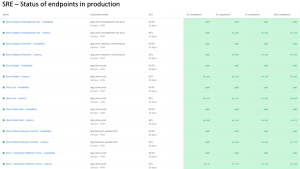The average engineer might leverage audit trails for compliance, but their benefits extend far beyond compliance. Leveraging audit trails can offer your organization more than simply adhering to legal requirements or telling you who did what and when.
But how much more? That’s a question this guide will answer.
In the following sections, you’ll not only learn how audit trails help pinpoint exact causes of system bugs and provide business insights into user behavior. You’ll also learn:
- What audit trails are and how they work.
- Key types of audit trails.
- Some best practices for audit logging and managing audit trails.
- Several benefits of implementing an audit trail system.
How audit trails work
Audit trails function by systematically logging and tracking changes within a system. When an action occurs (e.g., user login, data modification), the system logs details such as who, what, when, where, why, and how. This data is typically stored in a secure, immutable location, such as a database or dedicated log files.
Data logging involves capturing these events, while change tracking focuses on recording specific modifications to data or configurations. Logs are typically time-stamped, providing a chronological record. Centralized logging systems aggregate these logs for analysis.
Some systems, such as New Relic log management, go beyond simple aggregation. It integrates with its broader observability platform to contextually analyze all telemetry data, including logs, to provide a holistic view of system behavior.
Importance of audit trails in security and compliance
Audit trails establish a foundation of trust and accountability for the organization, developers and engineers, and even end users. Since these trails meticulously record data changes and user actions, they build a verifiable history that helps evidence due diligence.
For security, audit trails enable proactive threat detection, forensic analysis, and non-repudiation—all crucial for mitigating risks. For compliance, these trails demonstrate regulation adherence by providing immutable records of system operations, ensuring data integrity and transparency.
Types of audit trails
Audit trails can be categorized based on the type of activity they track and the systems they monitor. Here are some common types and contexts they may be used in:
- System audit trails track system-level events such as logins, configuration changes, and resource access. They are useful for deterring unauthorized access and intrusion attempts in security monitoring.
- Transaction audit trails track complete records of business transactions from initiation to completion. They are often used in financial auditing to ensure accuracy and prevent fraud.
- User activity audit trails track user logins, logouts, and actions they perform within a system. They can be used in security monitoring to enforce access controls and in user behavior analysis to better understand how users interact with the system.
- Network audit trails track network traffic and activity, including connection attempts, data transfers, and network configuration changes. They are typically used in performance monitoring to identify network bottlenecks and enhance network performance.
Best practices for effective audit logging
Want to ensure you create a reliable, actionable record of system activity? Start with the following audit logging best practices.
1. Choose the right logging tool.
The right logging tool will not only create an added layer of security, but also improve scalability and contribute to overall system health. Look for centralized logging, structured output like JSON, and robust filtering and searching. Other essential features that ensure both usability and security include real-time alerting, role-based access control, and immutable storage.
CTA: Take your audit data tracking to the next level with automation, full-stack visibility, and contextualized insights. Get started with New Relic today.
2. Configure logs for compliance and security.
Log everything relevant: who, what, when, where, why, and how. Mask sensitive data, maintain accurate timestamps, and ensure log integrity with digital signatures. Align configurations with relevant industry regulations such as HIPAA for healthcare or PCI CSS for payment card data, or with data privacy laws such as GDPR.
3. Store and manage logs efficiently.
Implement log rotation and compression to minimize space. Employ secure, encrypted storage with strict access controls. Define clear retention policies based on compliance and business needs, and regularly back up logs to prevent data loss; this will ensure both efficiency and data safety.
4. Analyze and respond to log insights with AI/ML assistance.
Analyzing logs should yield actionable insights, so real-time monitoring and correlation analysis are essential. Use artificial intelligence (AI) and machine learning (ML) for anomaly detection, which will help identify unusual patterns that may indicate potential threats. Develop incident response plans based on log insights, and conduct root cause analysis to prevent future issues.
Best practices for managing audit trails
Effectively managing audit trails is important for maintaining accountability, improving data integrity, and preventing fraud, among other reasons. Consider these audit trail best practices:
- Implement a centralized logging system to achieve a unified view of system activity and simplify analysis, correlation, and monitoring.
- Establish clear log retention policies to prevent excessive log accumulation while ensuring that necessary data is retained for audits and investigations.
- Secure log storage and access to protect logs from unauthorized access, modification, or deletion, and maintain audit trail reliability.
- Maintain accurate time synchronization to ensure consistent, reliable time stamps for correlating events and reconstructing action sequences.
Common audit trails challenges (and how to address them)
Audit trails are essential but can sometimes be an engineering headache. Here are a few challenges of managing audit trails you may face during implementation and maintenance:
- Data and storage volume can balloon quickly, leading to significant storage costs and management complexities. Address this through efficient log rotation, compression, and tiered storage approaches.
- Compliance can be complex and difficult to adhere to, so it’s important to fully understand and carefully implement applicable compliance standards.
- Logs pose security risks as they hold sensitive and identifying data. Overcome this challenge by masking or anonymizing data, encrypting logs, and using digital signatures to prevent tampering.
Benefits of implementing an audit trail system
The benefits of an audit trail system are numerous, but here are a few of the most compelling ones:
- They enhance security. Audit systems enable the detection of unauthorized access, suspicious activity, and security breaches, facilitating rapid incident response and forensic analysis.
- They ensure regulatory compliance. Audit systems provide verifiable evidence of adherence to legal and industry-specific regulations (e.g., GDPR, HIPAA).
- They increase operational efficiency. Audit systems quickly pinpoint the root cause of system errors and failures, reducing downtime and accelerating issue resolution.
- They improve transparency and trust. Audit systems provide a clear record of system activity, fostering trust and confidence among all stakeholders.
Nächste Schritte
Audit trails are vital for your business to ensure a secure system environment, meet compliance and regulation requirements, and maintain operational efficiency.
New Relic's instant observability platform perfectly complements audit trails by offering real-time monitoring and analysis of system performance and security with comprehensive visibility. Monitor everything in your stack—in one location—so you can proactively detect issues, rapidly respond to incidents, and maintain compliant systems. See New Relic's observability platform in action with this on-demand demo.
Die in diesem Blog geäußerten Ansichten sind die des Autors und spiegeln nicht unbedingt die Ansichten von New Relic wider. Alle vom Autor angebotenen Lösungen sind umgebungsspezifisch und nicht Teil der kommerziellen Lösungen oder des Supports von New Relic. Bitte besuchen Sie uns exklusiv im Explorers Hub (discuss.newrelic.com) für Fragen und Unterstützung zu diesem Blogbeitrag. Dieser Blog kann Links zu Inhalten auf Websites Dritter enthalten. Durch die Bereitstellung solcher Links übernimmt, garantiert, genehmigt oder billigt New Relic die auf diesen Websites verfügbaren Informationen, Ansichten oder Produkte nicht.



